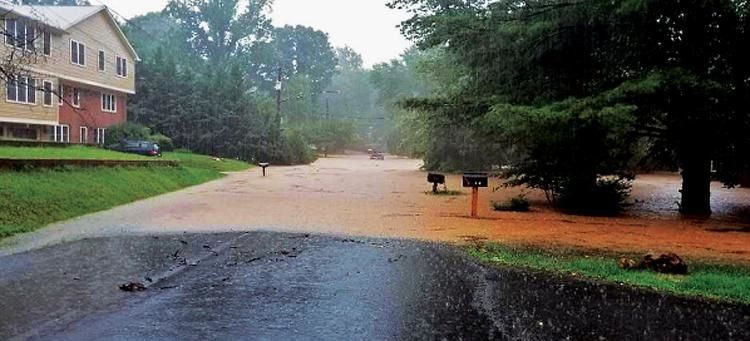This article was republished with permission from WTOP’s news partner InsideNoVa.com. Sign up for InsideNoVa.com’s free email subscription today.

This article was written by WTOP’s news partner InsideNoVa.com and republished with permission. Sign up for InsideNoVa.com’s free email subscription today.
The July 8 rainstorm that inundated Northern Virginia has lit a fire under Fairfax County supervisors to upgrade the county’s stormwater-management systems.
But as Department of Public Works and Environmental Services director Randy Bartlett made clear during the Oct. 8 meeting of the Board of Supervisors’ Environmental Committee, none of the available options is a panacea.
“There is no silver bullet, no one solution that solves everything,” he said.
The July 8 storm dumped 5 inches of water on the county in just one hour – something that in theory should happen about once every 1,000 years. Supervisors said the storm-frequency terminology used by county staff – while standard for the industry – seemed inadequate in the face of extreme weather that appears to be occurring more often.
To mitigate flood impacts, Bartlett said the county could:
• Enhance overland-relief protection and flood-proof homes: Overland methods of allowing water to run off of properties have the highest capacity, but can cause flooding in roads and often are impeded by obstacles, such as fences or gardens, placed in their path.
• Improve stormwater-conveyance systems: This would involve building such systems where none exist and installing larger pipes in existing systems. While these methods provide defined pathways for stormwater and can protect structures during routine storms, such systems tend to be overwhelmed by massive storms, can cause erosion from the concentrated water flow at the end of their pipes and effectively transfer the problem elsewhere.
This option also suffers from high costs, underground-utility conflicts, lack of space between houses and the need for property acquisitions.
“It’s not fair to push the stormwater problem onto somebody else,” said Supervisor Linda Smyth (D-Providence). “It’s going to take retrofitting to help with this.”
• Upsize the stormwater conveyance system: Putting in larger pipes would increase the system’s capacity, but also would be extremely expensive and difficult to construct on develop properties, have major utility conflicts, result in more concentrated downstream water flow and still be overwhelmed by huge storms.
• Upgrade existing road culverts: Fairfax County and the Virginia Department of Transportation since fiscal year 2016 have been pursuing this option together on 51 projects worth $4 million. This option protects roads and reduce upstream backups and vehicle losses due to flooding, but is expensive, entails utility conflicts and land-acquisition hurdles, and may require stream stabilization at the projects’ outfalls.
• Voluntarily acquire property: County officials could buy and raze homes in flood-prone areas and use those sites to improve water quality or detain floodwaters. But property acquisitions and home demolitions are expensive, inconvenient for homeowners, entail maintenance costs and may not qualify for Federal Emergency Management Agency hazard-mitigation grants.
• Implement stricter infill-development requirements: These could include limiting impervious-surface coverage on residential developments, requiring on-site stormwater detention and mandating that properties retain up to the first 2.5 inches of rainfall from the new impervious areas. These would have impacts only on a piecemeal basis, might lack sufficient space for on-site detention and would rely on homeowner maintenance.
• Enact administrative and financial provisions for new development or redevelopment: These could include development restrictions in flood-prone areas, prohibiting basements in floodplains, educating homeowners about risks and urging them to buy flood insurance and install flood-proofing measures. But these actions also would restrict land use, affect structures and not address current flooding issues.
Bartlett showed how much more intensive county stormwater-management efforts have become in the last 80 years. County officials installed a stormwater-conveyance-pipe system in the 1940s to deal with nuisance flooding; implemented an erosion-and-sediment-control plan and developed floodplain restrictions in the 1970s; and conceived a master drainage plans and a regional stormwater-management plan, implemented a water-supply protection-overlay district and developed stormwater-detention requirements in the 1980s.
The 1990s saw increase water-quality-protection efforts, including adoption of stormwater best-management practices requirements and institution of the Chesapeake Bay Preservation Ordinance and Resource Protection Areas. Those efforts intensified during the 2000s with the implementation of stream physical assessments, watershed-management plans and a stormwater-management tax based on assessed property value.
Bartlett showed aerial photos of the same neighborhood, one taken in 1990 and the other in 2017. The latter photo showed several bigger houses had replaced smaller ones, increasing the amount of impervious surface and making stormwater management more challenging.
Supervisor Jeff McKay (D-Lee) suggested the county could use stormwater revenues to buy some homeowners associations’ stormwater facilities and then enhance their capacity.
Bartlett’s recommended the county use stormwater funds for roadway stormwater improvements; when upsizing pipes, install ones capable of handling 100-year storms; map minor floodplains; require designation of overland-relief paths on plats; purchase properties if mitigation solutions are more expensive; and encourage people to buy flood insurance.
Residents usually prefer that stormwater flows in a channel, not over land, said Supervisor Penelope Gross (D-Mason).
“Water does run downhill,” she said. “We can legislate all we want, but we can’t change nature.”
Supervisor John Foust (D-Dranesville) agreed, adding he had photos of flooded streets “where you’d think you were on the Colorado River.”
“We need to get more water into some kind of conveyance system that is not freely flowing,” Foust said.







